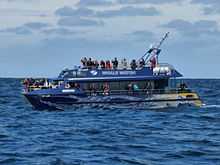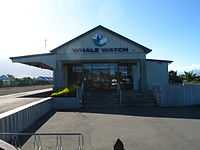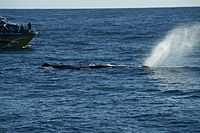Whale watching in New Zealand

Whale watching in New Zealand is closely associated with the town of Kaikoura. Known as the 'whale capital', it is a world-famous whale watching site, in particular for sperm whales. Whale watching is also offered in other locations, often as eco-tours and in conjunction with dolphin watching. Land-based whale watching from New Zealand's last whaling station, which closed in 1964, is undertaken for scientific purposes, mostly by ex-whalers. Some compilations of sighting footages are available on YouTube.[1]
Background
Many places that were formerly whaling stations went into recession after the collapse of the whaling industry; New Zealand stopped whaling in 1964.[2] Whaling did not stop due to environmental or ethical concerns but because the declining number of whales made the industry uneconomic. Whilst New Zealand protected right whales in 1935, it was not until 1978 that all marine mammals were protected by law.[3] Kaikoura's recent development has been used to advocate the benefits of whale watching over whale hunting. Due to illegal whaling by Soviet Union (with help of Japan) in the 1970s, recovery state of baleen whales migrating to New Zealand coasts were heavily slowed down, far worse than in Australian waters, and this contributed to make public images that Kaikoura is the only site for whale watching, and Sperm Whale is the only species can be observed normally. New Zealand is the first nation in the world to protect marine mammals by law.
Hauraki Gulf
Waters in Hauraki Gulf and Bay of Islands are home to several species of cetaceans, most notably for Orca, the Killer whales and Bryde's whale, the only baleen whale species of residential in the nation. However, this local stock is critically endangered, numbering of around 50 individuals left. Little Barrier Island is a migratory collider and resting/calving ground for baleen whales.
Kaikoura
The sea around Kaikoura supports an abundance of sea life, with the town's income stemming largely from the tourism generated from whale watching and swimming with or around dolphins. Recently the sperm whale watching at Kaikoura has developed rapidly and now it is an industry leader; arguably the most developed in the world.
The dominant organisation in Kaikoura's whale watching industry is Whale Watch Kaikoura, which is run as a charitable organisation. It takes around 100,000 visitors out by boat per annum, and has an annual turnover of NZ$10m.[4] Whale Watch Kaikoura began operating in 1987 with a 6 metres (20 ft) boat.[3] Whale watching is also done by air, and the Kaikoura Aerodrome is mainly used for whale spotting tourist flights by Wings over Whales and Air Kaikoura - Kaikoura Aero Club.
 Kaikoura whale watch centre |
 Sperm whale eating a fish off Kaikoura; surface feeding is not normal behaviour |
 Whale watching by plane, with Kaikoura Peninsula visible in the background |
Tail fin of a sperm whale |
 Whale watch boat and whale |
Tory Channel
New Zealand's last whaling station was in Whekenui Bay in Tory Channel in the Marlborough Sounds. The high cliffs at the entrance of Tory Channel are ideal for land-based whale watching. During the migratory season for whales, the lookout is manned and whales passing Cook Strait are watched for research purposes.[5] Most of the volunteers undertaking the work are ex-whalers.[6] It is also the location where the first Southern right whale on main islands sighted since the end of whaling. Cetaceans can be seen in Waikawa, Picton,[7] French Pass, and in Abel Tasman National Park as well.
Other locations
Whale watching, in conjunction with dolphin watching, is already offered in the Bay of Islands[8][9] and Moutohora Island (also known as Whale Island) in the Bay of Plenty.[10]
Future developments
Other locations (or anywhere else) in the nation, such as at bays on Aupouri Peninsula, Rangaunu Harbour, Whangarei Harbour, Firth of Thames, Tamaki Bight, eastern Coromandel Peninsula,[11] Mount Maunganui, Hawke's Bay, Castlepoint, vicinity to Wellington, South Taranaki Bight, New Plymouth, Kapiti Island, Golden Bay, Hokitika, Banks Peninsula, Moeraki and Karitane, Otago Peninsula, Taieri Mouth, Nugget Point,[12] The Catlins,[13] Port Craig in Te Waewae Bay, Fiordland, Paterson Inlet, Chatham and Kermadec Islands may possibly become watching locations in the future when numbers of whales migrating into coastal waters show recovery. Sighting numbers of Southern rights, Humpbacks, Blues are showing strong increases in recent years.
Southern right whales, Tohora, 'the most important whale to New Zealand' is very slowly, but steadily making come backs to the nation's waters, and they will possibly become one of the most important species for whale watching as well since they are renowned as a target for non-harmful, land-based watching, and will recolonize the shores of the entire New Zealand to become seasonal residents.[14] (see also Whale Rider, and "real whale riders" sometimes appear for this species[15]). For Southern blue and Pygmy blues, even before the historic discovery of a forging ground off Cape Egmont, whales have been showing come backs along the coasts especially in Northland waters such as off Bay of Islands, Tutukaka, and Kaikoura. Fin whales and Sei whales are confirmed in Chatham Rise in good numbers, but less frequently seen in coastal waters. Minke whales can be seen off entire nation especially in Bay of Islands, but due to their small size it is not easy to observe them. Beaked whales are occasionally seen. Of these, most frequently observed species are Arnoux's beaked whales (once a group of these had become a regular annual to Doubtful Sound[16][17]) and Gray's beaked whales. New Zealand's coasts are also renowned as prominent habitats for curious, ray-hunting Orcas.[18][19]
References
| Wikimedia Commons has media related to Whale watching in Kaikoura. |
- ↑ Imai Y.,MrDaniel0816's channels
- ↑ "Whale watching video". Department of Conservation. Retrieved 30 April 2014.
- ↑ 3.0 3.1 Phillips, Jock (13 July 2012). "Whaling - Modern whaling and whale watching". Te Ara: The Encyclopedia of New Zealand. Retrieved 30 April 2014.
- ↑ Morton, Jamie (28 March 2014). "Study questions impact of whale watching". The New Zealand Herald. Retrieved 30 April 2014.
- ↑ "Whalers out for the count". Stuff. Retrieved 14 January 2015.
- ↑ "Whale Watching". Television New Zealand. Retrieved 4 May 2014.
- ↑ http://www.naturetours.co.nz/new-zealand/Dolphin-Seal-sightings/
- ↑ "Paihia Attractions". Paihia Community Website. Retrieved 4 May 2014.
- ↑ "Whales". Fullers GreatSights Bay Of Islands. Retrieved 4 May 2014.
- ↑ "Dolphins and Whale Island Eco-Tour". Diveworks Dolphin and Seal Encounters. Retrieved 4 May 2014.
- ↑ "Whale watching from sea kayaks in the Coromandel, New Zealand ~ Jon Traylen". YouTube. Retrieved 14 January 2015.
- ↑ http://www.panoramio.com/photo/18808971
- ↑ "Catlins Marine Encounters's Photos - Catlins Marine Encounters - Facebook". Retrieved 14 January 2015.
- ↑ "Southern right whale back in NZ waters". TVNZ. Retrieved 14 January 2015.
- ↑ https://www.facebook.com/photo.php?fbid=165565816789382&set=a.151625964850034.29239.151318038214160&type=3&theater. retrieved on 13-05-2014
- ↑ Matthews Z., Whales at Doubtful Sound, Fiordland Kindergarten-Blog of Fiordland Nature Discovery, 28 April 2009, http://fiordlandkindy.blogspot.jp/2009/04/whales-at-doubtful-sound.html., retrieved on 05-05-2014
- ↑ Department of Conservation, April 2011, Fiordland Coastal Newsletter - Conservation for prosperity – Tiakina te taiao, kia puawai, http://www.fiordlandhelicopters.co.nz/wp-content/uploads/2011/05/Fiordland-Coastal-Newsletter-April-2011.pdf., retrieved on 05-05-2014
- ↑ "2014 March Orca at Maraetai New Zealand". YouTube. Retrieved 14 January 2015.
- ↑ "Beautiful Orcas in New Zealand". YouTube. Retrieved 14 January 2015.